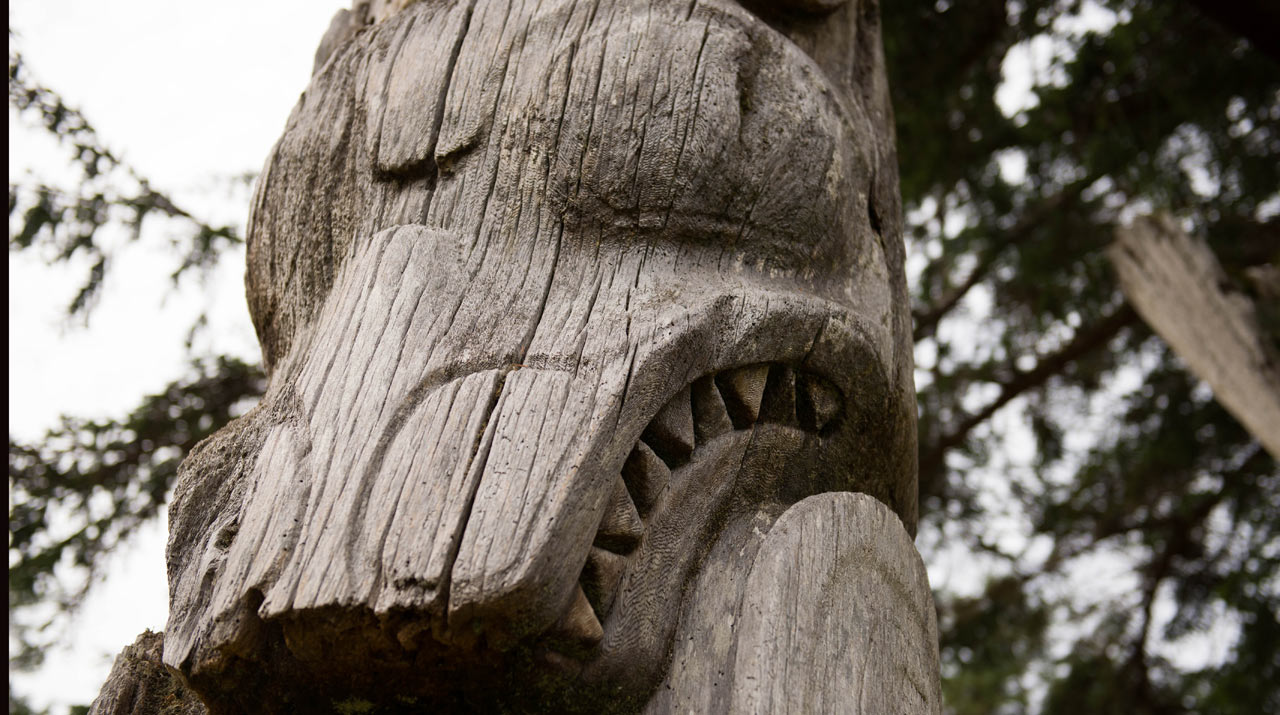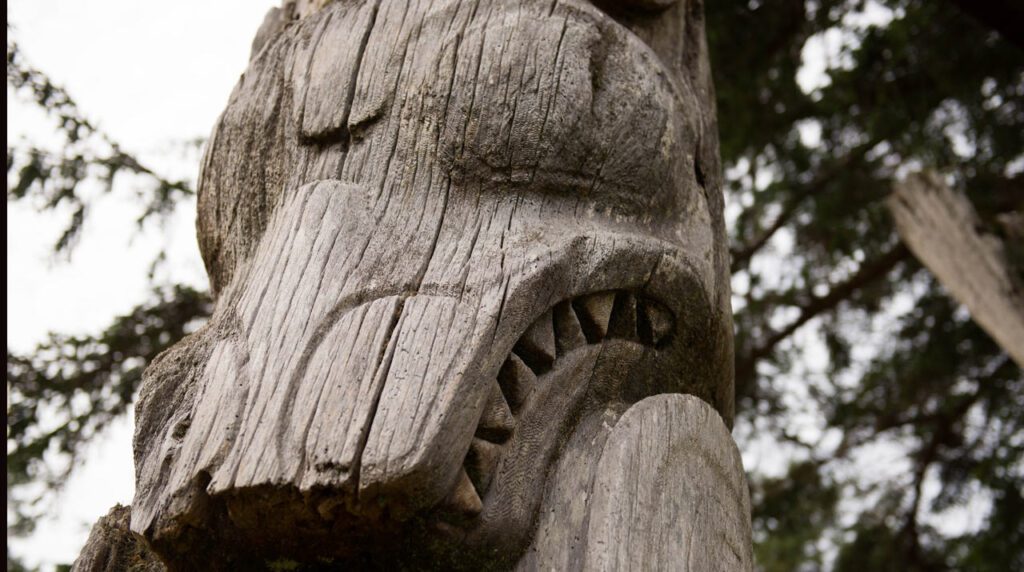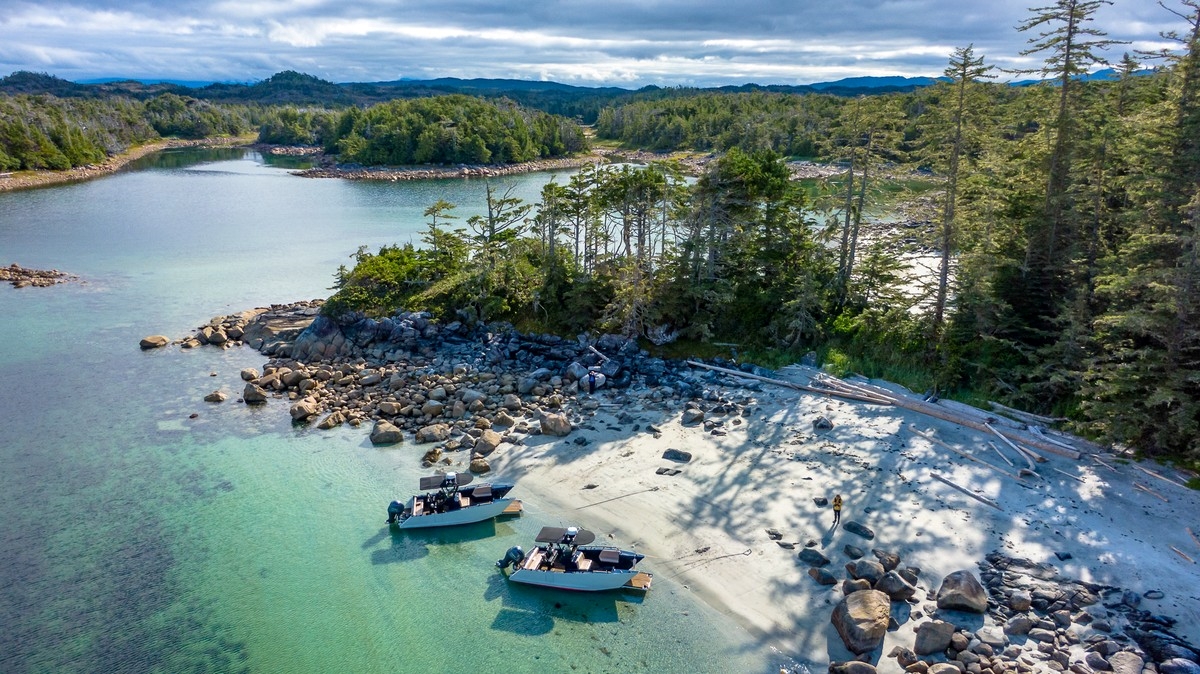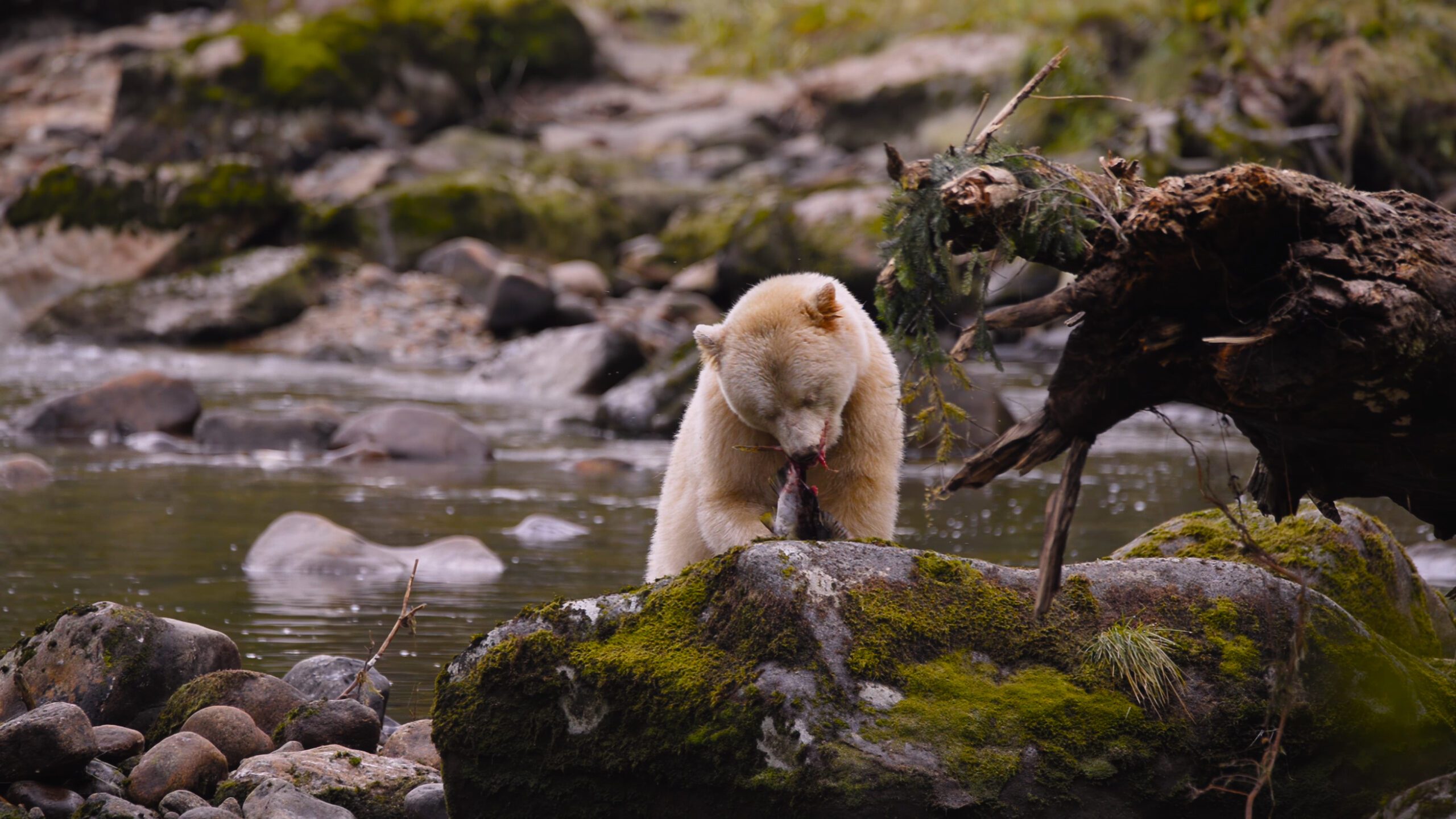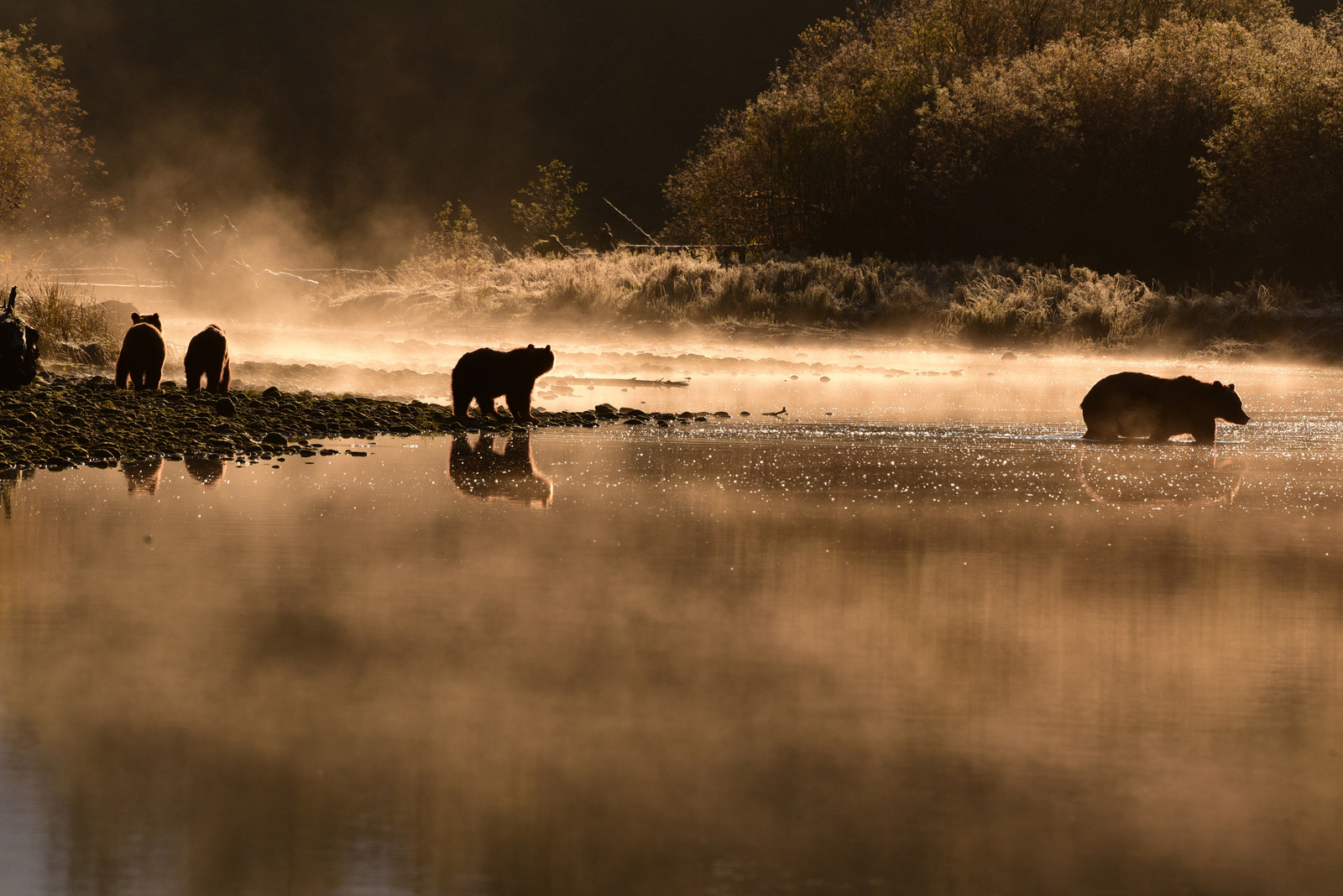Here are the reports from our boutique expedition cruises on the British Columbia, Canada, and Alaska coast.
Most recent trips are at the top.
Great Bear Rainforest Oct 5-13, 2016, aboard SV Maple Leaf
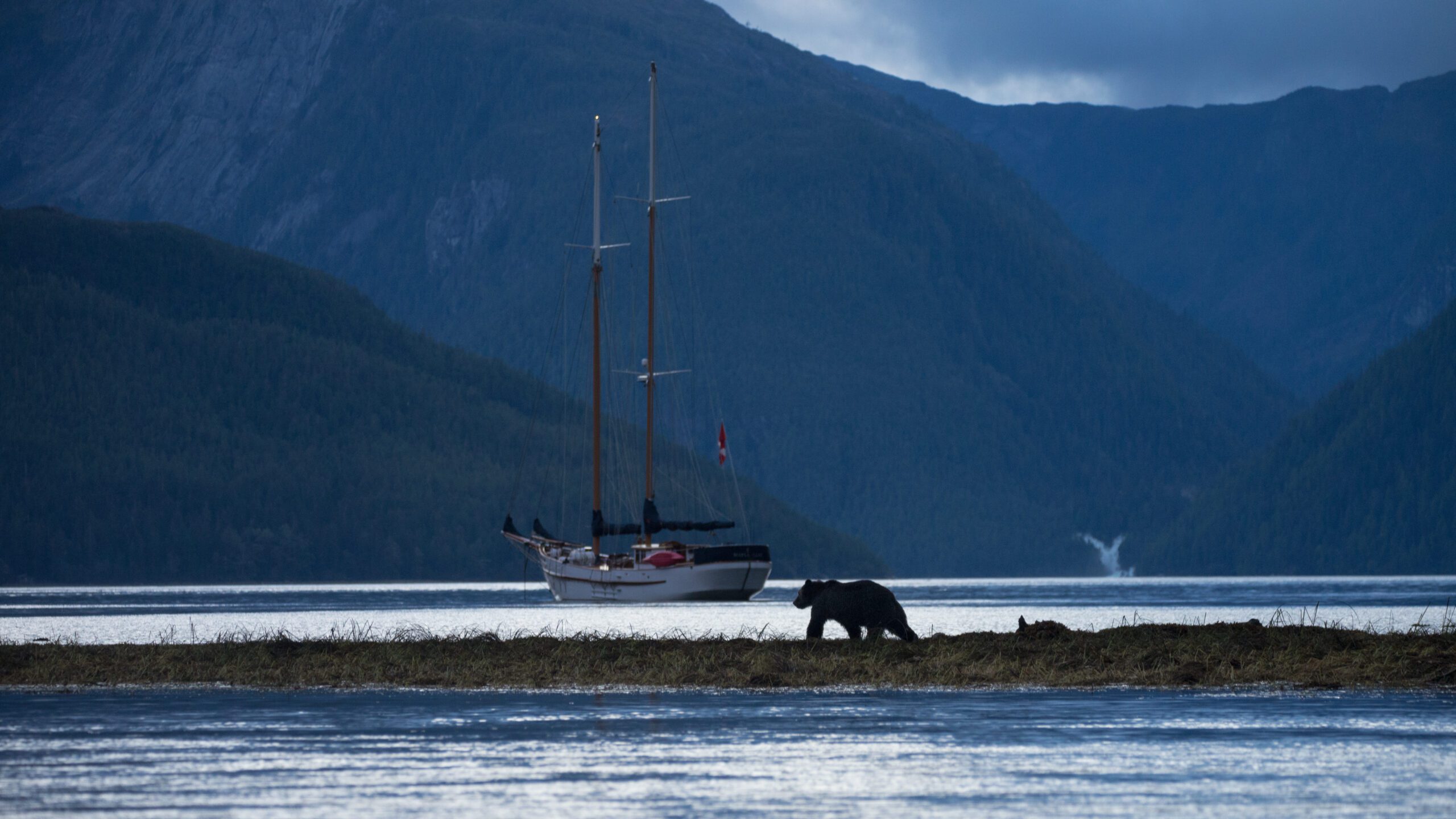
Thanksgiving Update from the Ship
There’s a chilly, fall bite to the air in the Great Bear Rainforest. The morning mists forming a magical veil over the water at anchor. The rivers are becoming quiet as the last few straggler salmon slowly glide from eddy to eddy. Many of the bears have headed inland now but we’ve seen several families of mother grizzlies with cubs digging for roots in the estuaries of the inlets. As we cruised down a fjord, a silent pod of mammal eating Biggs orca slipped between the towering granite walls, doubtless hoping to trap some porpoise or sea lions in the lagoon at the end.
As we made our way through Mackay Reach the ocean burst with the thunderous surfacing of a pair of bubble-netting humpbacks. We watched for several lunges as the tiny, silvery herring boiled at the surface. Yesterday, we ventured up a small rainforest river valley with a local Gitga’at guide to search for a white, Spirit Bear. After a brief early morning glimpse and a long wait, a female Kermode bear at last slipped out of the shadows, down the fern-clad river bank to peer for the few remaining salmon skulking in the dark pools. Our group was treated to a wonderful experience, and the chatter later around the galley table, as we enjoyed chef Yasmin’s enchanting tapas, was alive with the excitement of the day.
Onward we go, southward now along Squally channel into the realm of the rorquals. Giant Fin Whales and breaching Humpbacks are all around. We have much to be thankful for as the first year of a protected Great Bear Rainforest draws to a close and S.V. Maple Leaf makes plans to head to the south coast…
– update from naturalist Phil Stone
Great Bear Rainforest, Oct 3-11, 2016, aboard MV Swell

update from halfway through the trip….
We excitedly gather at the airport in Kitimat and wait for the van which will take us down to tidewater. We pass through seemingly endless forest of spruce, amabilis fir, hemlock and aspen. Everybody busily natters about where they are from and what they hope to see. In an hour or so we arrive at the dock and eagerly go down the ramp to the Swell, our home and transport for the next eight days. We leave the dock and our adventure begins.
Once settled, everybody is out scanning for spouts. It dose not take long to spot a humpback whale, and then four more. Dall’s porpoise play with our bow wave; people scream with delight! We pause at Weewanie hot spring and most had a good soak. Along the trail from the beach we find a few edible delectable mushrooms including 2 large boletes and angel wings. James cooks them for dinner, a rare treat for all. What a start to the trip! (28NM)
The next day we are cruising down Douglas Channel watching for more whales or bears. We anchor in Home Bay for the night. (28NM)
The next day everybody was anticipating: the quest for spirit bears! We are off to a special place where about one third of the black bears are white. We land at the mouth of a small creek and climb up over boulders with the help of a rope. Then we walk for a kilometre or so to a viewing platform which has been reserved for us for the day. We are met by two youths, Chris and Jolene, from the nearby village. For more than 2 hours we hopefully scan up and down the creek looking for the iconic white bear. Finally one is spotted slowly making its was down the creek toward us. Soon it was only 100m away, feeding on morsels it picked up from earlier kills. Cameras buzzed. Later, the spirit bear left and we counted 5 black-furred bears. We all whispered. Just when we were getting cold and hungry Capt. Steve arrived with hot drinks and food. Very satisfied, we head on to a beautiful cove for the night (54NM)
**
We were up and out before dawn with night-viewing equipment to see if the wolves were here. They were! Four of them!! Later, after warming up on Swell, we sail south again in the sun, past Gil Island, to the west side of Campania Island. Here, we land on a beautiful beach with lots of moon snails. A rough trail led in and up to a large bog. We admired the specialized plants that manage to exist here and we wondered why there were so many large abalone shells on top of a small hill. We concluded that eagles carried them up from the intertidal to eat in peace.
We headed for a lovely anchorage for the night with a guest catching a 10 kg halibut en route. The delicious dinner of very fresh halibut he shared was something to die for.
The next day we had to be satisfied with watching humpback whales bubble-net feed, time after time in front of Cetacealab. How marvellous! Nearby, we motor close to a Steller sea lion haul-out, which also housed harlequin ducks, pelagic cormorants and surf birds.
We still have a long way to go so we head north, and east to Princess Royal Channel and south a beautiful mainland inlet. On the way we stopped at Butedale, an old large cannery, now a historical site. The watchman gave us an excellent tour. Humpback whales nearby. When are they not?
At the head of the we scan for grizzly bears; only a few seals. After breakfast we take 2 small, rigid-hull inflatable boats slowly up the river, looking carefully for bruin. On the bank, there was plenty of bear sign. It looked as if much of the meadow had been roto-tilled by bears looking for the herb Angelica. Snuffling noises came from nearby and a very large sow bear stood up. Three cubs appeared. Everybody climbed the bank for a look. We returned an hour later and the sow and cubs were in full view, a mere 10 meters away. We also watched a sow and 2 more cubs on the other side of the river. What a day!
We travel south and anchor for the night at the village of Klemtu. Everybody enters the Big House, a fairly new, huge building. Vern Brown gave an excellent talk on the local culture and answered lots of questions. Tomorrow off to Fjordland!
– update from naturalist Bristol Foster
Great Bear Rainforest, Sep 25-Oct 2, 2016 aboard SV Maple Leaf
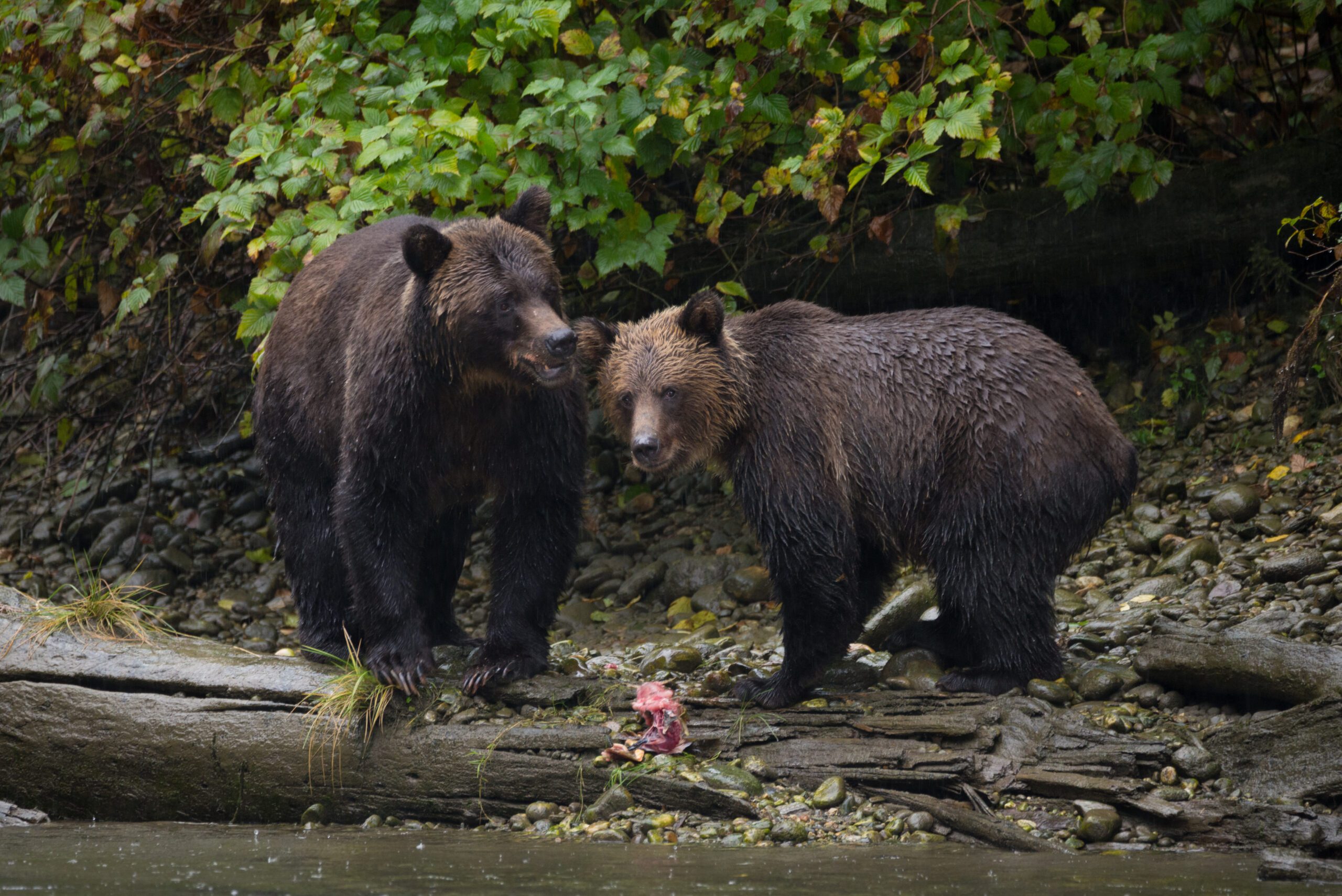
Gale force winds and torrential downpour greeted us for the beginning of our great bear rainforest trip this fall. Characteristic weather of this region didn’t slow us on our departure from Bella Bella and our captain, Kevin Smith outmaneuvered ocean swells and brought us into calm waters in a protected channel. Our guests on board, clearly excited for the beginning of our adventure and full of our chef’s fine cooking, had tucked in for the night.
The following days have been fantastic! Navigating through the glacier-carved fjords in blue skies is breathtaking. We have spotted many humpback whales and Dall’s porpoise everyday, and we continue to search the seas for new surprises.
Fine weather and excellent planning has allowed us to maximize our time ashore. At a beautiful inlet, we observed a grizzly bears swimming along cliff faces in search of salmon and munching shore crabs on the tide flats.
We explored meandering rivers, hidden waterfalls and shallow sandbars in a massive river estuary, which led us to find a mother grizzly with her three year-old cubs.
Star gazing, bioluminescence and hot springs made for a magical evening at Bishop Bay.
Which brings us to today’s hike into a special island where we found ourselves overawed in the presence of a spirit bear fishing the river. We have only reached the halfway point in our journey and it is hard to imagine what we will find next!
– update from naturalist Matthew Burnaby
Great Bear Rainforest, Sep 15-23, 2016 aboard MV Swell

Our trip through the Great Bear Rainforest onboard MV Swell has been sublime!
After kicking off with an incredible experience with the spirit bears we thought little could top it.
But the beautiful BC coast showed its enduring magic with regular sightings of humpback whales feeding and travelling the many channels & fjords; a rain-soaked sighting of magnificent grizzly bears; gargantuan fin whales, sun-kissed white sand beaches on a west coast island, and an enchanting encounter with the A30 Northern resident rrcas as we neared the journey’s end in Bella Bella.
It was a very happy group we said good bye to, heading off on new adventures with fond memories from the Great Bear!!!!
– update from naturalist Phil Stone
Alaska Adventure, Aug 15-25, 2016, aboard MV Swell
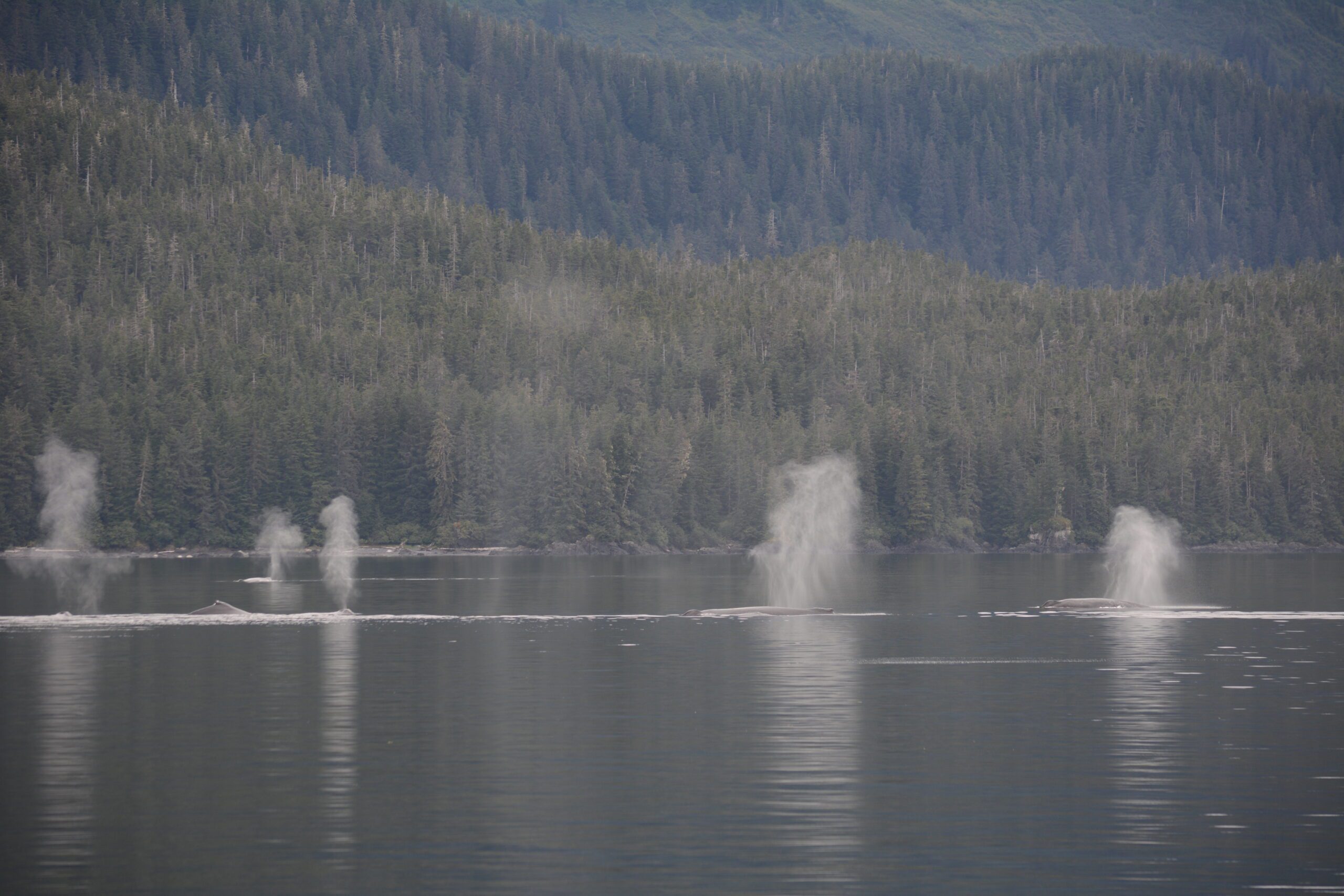
First of all, we are so blessed with the amazing weather: warm, dry and So Calm. The morning fog has lifted and we can see dozens of humpback whales, in ones and twos, blowing tall spouts, deep diving to show the silhouette of their tails, for far as the eye can see across the flat calm water.
We notice a larger group of humpbacks up ahead a-ways. They are so close to each other they must be touching pectoral fins and one or two are breathing then diving in unison like giant synchronized swimmers.
We realize this is the perfect condition to put out the hydrophone and prepare to shut down and drift.
We are gathered on the front deck, hydrophone cable hanging from the starboard bow. At first quiet whispers come through the little speaker. Then we start to hear complicated clicks and rumble sounds, rising siren-like. Amazing. Sure sounds like they are communicating with each other. The whales are off towards shore, far away. We hear one trumpet call through it’s blowhole with its whale-sized exhale: first through the hydrophone speaker then from the surface a second later! Audible proof to us that sound travels faster in water than in air.
Humbling to realize these huge animals are here so separate in their world and so much a mystery. We quietly float and drift, talking in whispers. We listen to the whales, watching them rise and blow, and grateful for sharing this time and place together.
– update from naturalist Mary Morris
Alaska Adventure, Aug 6-14, 2016, aboard MV Swell
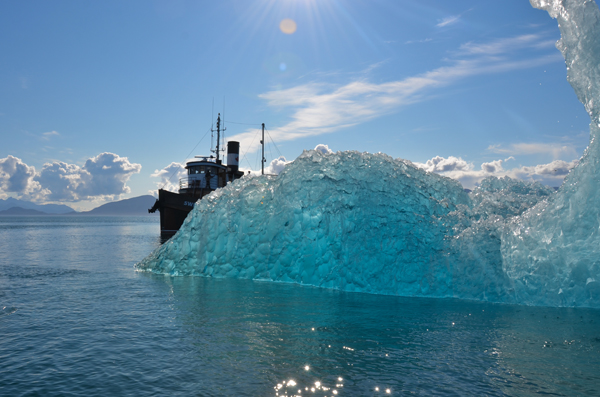
MV Swell naturalist’s journal
Day 1 August 6th
We began our trip by motoring to Cannery Cove on Admiralty Island where we anchored for the night. As we entered Frederick Sound, we were greeted by our first humpbacks.
Day 2 August 7th
We had an early start as we had some distance to cover today. Our first activity was to try halibut fishing in the cove. Within 5 minutes, one of the guests had hooked a 38 lb halibut which we soon had on board. As we made our way to Warm Springs Bay, we were accompanied by Dall’s porpoises at the bow as well as humpbacks breaching. In Warm Springs Bay, we paid a visit to the whale researchers from the Alaska Whale Foundation who answered our questions and told us about their work. After that we made our way up to the lake where some of us took a quick dip in the cold water before making our way back to the hot pools. We then set off for Mole Harbor on Admiralty Island. During our cruise we were treated to more porpoises at the bow as well as a group of humpbacks feeding cooperatively on herring along the shore. Seeing their large pleated mouths engulf a school of fish is spectacular!
Day 3 August 8th
Today we spent our day watching brown (grizzly) bears feeding on salmon at Pack Creek. Despite the rain we had a great viewing experience with half a dozen bears. In the afternoon, a group of us hiked up to the observation tower – a wonderful walk through the forest past bear scat and a bear rubbing tree. At the tower we watched pink salmon spawning. After we were done watching bears, we set off for Wood Spit, our anchorage for the night.
Day 4 August 9th
We motored down Endicott Arm towards the Dawes glacier. The fjord is a magnificent U-shaped valley with several hanging valleys creating spectacular waterfalls. Once we neared the glacier, we set out in the zodiacs and came close to the towering front of the tidewater glacier. While we watched the glacier we were treated to two excellent calving events where bungalow-sized chunks of ice fell off the front of the glacier into the fjord creating six foot swells for us to ride. Harbour seals were scattered over some of the floating ice and we could hear the ice sizzling. Before we returned to the Swell, we “harvested” a nice chunk of ice to keep for the evening…. On our way back out of Endicott Arm, we stopped to visit “Ford’s Terror” a spectacular narrow channel with fast currents opening into a valley full of beautiful waterfalls. The day finished with sunshine and we made drinks with our glacier ice!
Day 5 August 10th
Today dawned with rain and wind, but we decided to visit the Brothers Islets anyway. We were treated to sea lions frolicking around the dinghy as well as lying around on the beach. After our sea lion excursion, we began to make our way towards Thomas Bay and were treated to the spectacle of a humpback breaching for us more than a dozen times – some quite close to the boat.
Whales & Totems Aug 1-6, 2016, aboard SV Maple Leaf
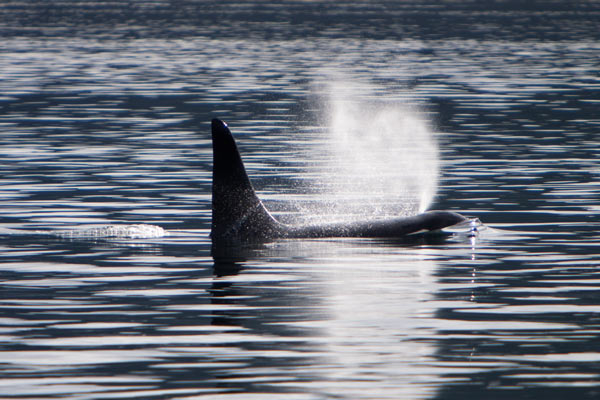
From Aug 4 & 5:
Over 25 “Northern Resident” Orca were seen – the A30, A42 and A34 matrilines. A46 (“Kaikash”) now the only remaining member of the A36 matriline is now travelling with the closely related A34s. Saw a great diversity of behaviour and had a fantastic opportunity to listen to vocalizations while the A34s were socializing.
Dalls Porpoises and Humpbacks were also feeding in the big tidal exchange and 5 individual Humpbacks were identified – “Ripple”, “Argonaut”, “Quartz”, “Ridge” and “Freckles”. We briefly saw Ripple trap-feed, a novel feeding behaviour being studied by the Marine Education and Research Society.
Interesting too is that there were more Cassin’s Auklets in the area than we have ever noted previously.
– update from naturalist Jackie Hildering
Alaska Adventure, July 28-Aug 5, 2016, aboard MV Swell
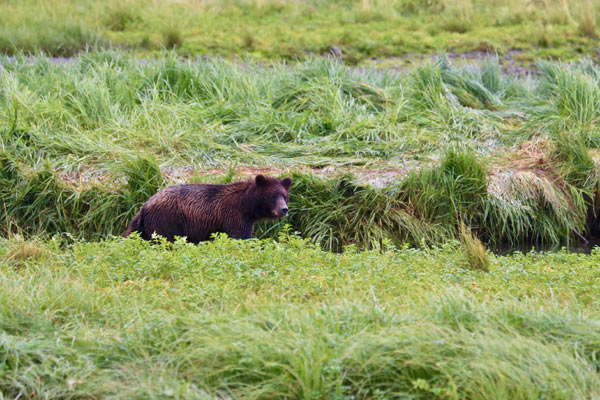
We have had an amazing few days exploring south-east Alaska!
Day 3
On day 3 we travelled from Deep Bay, Chicagof Island, around the northern side of Baranof en route for the hot springs and community of Baranof in Warm Springs Bay. While under way we saw our first humpback whale and then stopped for lunch by the scenic Kanyku falls. We took a short zodiac ride to explore the falls up close and then weighed anchor for Warm Springs Bay. No sooner had we left the Bay than we encountered a humpback whale feeding along the shoreline where we had just been travelling in the zodiac. We stopped and watched it corral fish and then lunge sideways to engulf a small school of fish. Once we arrived at Baranof we took a short hike up to Baranof lake and then enjoyed a dip in the hot springs. We returned to the Swell and then groups of us went in kayaks to explore the rich intertidal life found in the channel where the lagoon empties with the tides. We saw sea anemones, sea cucumbers, sea stars, barnacles and mussels as well as the “leafy hornmouth” (a snail that preys on the barnacles). We returned on board for a delicious dinner created by our chef, James.
Day 4
After some of us had done some early morning kayaking, we took the zodiac out for a tour of the bay. We had another look at the rich intertidal life and made our way to a scenic bay where we were treated to a good view of a small brown bear exploring the shore. We weighed anchor and set out for Admiralty Island and Frederick Sound. As we rounded the southern tip of Admiralty Island, we saw a humpback breach over by Murder Cove and went over to investigate. We were treated to blows, tail flukes and then a display of lunch feeding through schools of tiny fish. We continued on our way to an islet by the Brothers Islands which was home to a rookery of a few hundred Steller sea lions. We explored the shoreline by zodiac and were treated to the sights, sounds (and smells!) of a sea lion colony. After our visit we made our way to Cannery Cove on Admiralty Island for the night.
Day 5
After some more early morning kayaking, we weighed anchor to make our way to Windfall Habor, further up the coast of Admiralty Island. On our way out of the cove we stopped by a reef to try our hand at fishing. Within a few minutes, one of our guests had hooked a 34 lb halibut which we landed successfully! As we made our way north from Frederick Sound, we suddely found ourselves surround by humpbacks everywhere we looked. Though they were too numerous to count, we estimate that we saw at least 50! We saw whales surfacing, diving, breaching, tail and fin slapping in every direction. Frequently the whales were in groups of two to four. We also saw a group of two orcas as well as Dall’s porpoises and a solitary sea otter. We made it to Windfall harbour late in the afternoon and saw a very dark grizzly (brown) bear feeding in one of the creeks. We then went on a shore walk where we saw lots of evidence of bears – footprints, beaten vegetation, trackways, scat and more – but no bears until we were returning to the Swell in the zodiac. We decided to go and check this bear out and were treated to another good view. Dinner this evening was delicious fresh-caught halibut!
Day 6
Today we went to Pack Creek, which is a special site where many brown bears have become accustomed to visitors to the point they ignore them. In the morning, we sat in a small area of the spit and were treated to close-up views of a sow bear and two cubs who stayed with us for three and a half hours. In the afternoon, we returned to the spit and spent another two hours watching a young male chasing (and occasionally catching) fish. He was later joined and displaced by an older and larger female bear who fished by standing still in the creek and then pouncing. It was interesting to see how individual the bears are. Returning on board after a long day of bear-watching we set off for Wood Spit.
– report from naturalist Mike Jackson aboard Swell
Whales & Totems, July 26-31, 2016, aboard SV Maple Leaf
It was a great trip!
In addition to our time with whales and visting the islands and communities, some other highlights:
– Rare sea otter sighting at mouth of Knight Inlet!
– Sailing down Johnstone Strait to our night’s anchorage in Boat Bay.
– A foggy visit to a seas lion haul-out followed by TONS of dolphins in Fife Sound.
report from Capt. Tavish Campbell
Alaska Adventure, July 19-27, 2016, aboard MV Swell
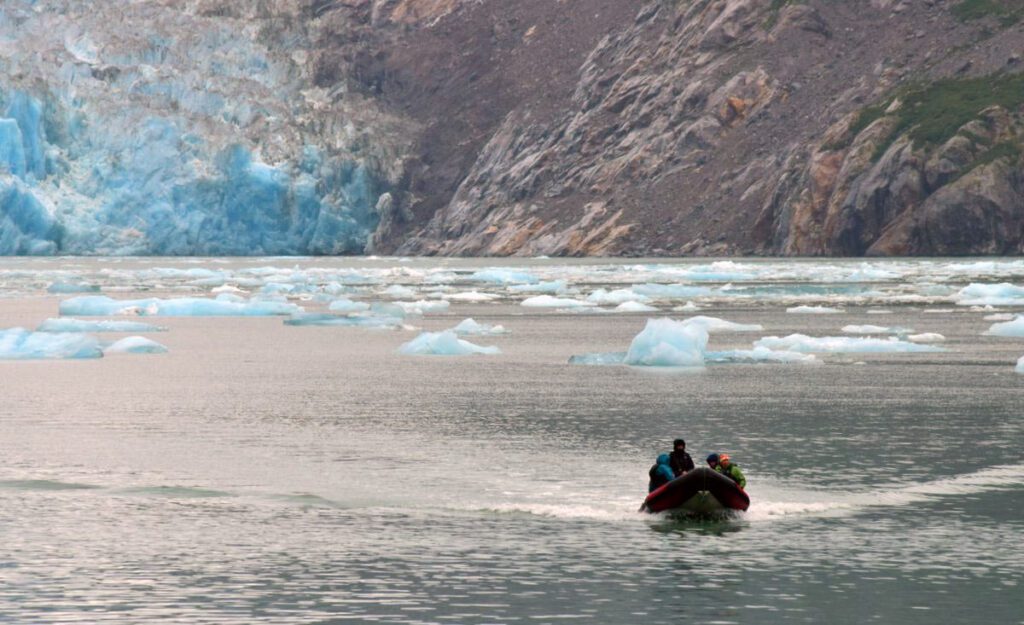
Update #1 (day 3)
We are off on a unique trip where family members have come from all parts of the globe—South Africa, Scotland, England, British Columbia, and Ontario to join us on Swell in Southeast Alaska. Our voyage began in Petersburg and on our first full day of travelling we saw Humpback Whales (some breaching!), Killer Whales, Steller’s Sea Lions, Harbour Seals, Dall’s Porpoises, and even a Sea Otter.
We spent a full day in a glacially carved fiord. Here we saw our first bear—a black bear.
Further along we got into our skiffs and made our way through floating ice to get close to the face of a tidewater glacier. Not only did we see the glacier calve, we also watched as huge ice chunks emerged from below the water! The whole area was alive with the sounds of the moving glacier and the bergy seltzer crackling in the water. Birds such as Arctic Terns and Black-legged Kittiwakes fed on food stirred up by the calving glacier and we also watched Harbour Seals hauled out on the ice or swimming about.
Later we went for an explore in a tributary fiord called Ford’s Terror due to the tidal currents. Massive rock walls and huge waterfalls were highlights of this adventure.
Update # 2
We spent a day at Pack Creek on Admiralty Island, which is known for its large population of Grizzly Bears. As we walked out to our viewing area, we saw our first bear sauntering across the estuary. We later spotted a mother with two very playful cubs, and finally another bear that chased and caught salmon in the stream. We also had a lovely hike through a forest to a viewing tower, and while there were no bears there, we watched spawning salmon in the river below.
We tested our sea legs in a “Southern Buster” and were rewarded at the end of a difficult passage with Humpback Whales and a rainbow. Our next passage ended with a Grizzly Bear in front of a waterfall. We were ready for our soak in a natural hot spring located right beside a roaring waterfall. A special treat was having volunteers from the Alaska Whale Foundation come on board to talk about the research they are doing in the area.
Update # 3
The following day we saw two more groups of Killer Whales, and one had whales that were tail-slapping and spy hopping. We also saw a group of Humpback Whales that had been bubble-net feeding. We had some success with fishing that saw a tasty appetizer served at dinner and we celebrated a wedding anniversary of two of our guests with wine and cheese.
An epic hike saw us travel from an estuary filled with bear poop, diggings, and tracks up into a magical bog forest. There we saw the carnivorous sundew! We carried on to a beautiful wild west coast beach where we explored the vast expanse of white sand. All too soon it was time for our farewell dinner. Alaska has touched each of us in a very special way.
Whales & Wild Isles (Great Bear Rainforest BC), July 16-24, 2016, aboard SV Maple Leaf
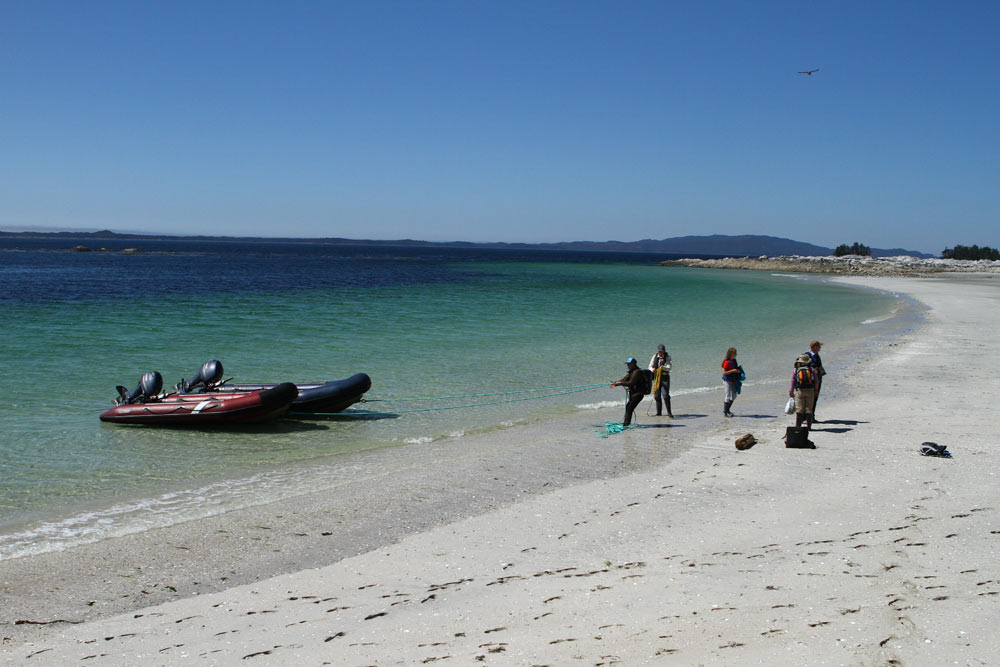
At Kitamaat village, a welcome from Haisla/Henaksiala elder Cecil Paul to his territory provided a beautiful start to the journey.
As we left behind the signs of industrial logging and LNG projects down Verney Pass, we came onto three very inquisitive humpbacks, one of which had orca teethmarks on his tail. Easy to identify,the humpback was called Andre Junior by Janie Wray and Hermann Meuter at Cetacea Lab at the south end of Gil. Our guest Andre was delighted to meet his equal at fishing salmon!
After an afternoon with Janie and Hermann of talking and watching whales, including fin whales, we tucked into Campania and had a sunset dessert and bonfire on the beach with a raft of marbled murrelets calling their characteristic keers. The night was interrupted by a May Day call from a nearby sport fisherman who had got himself into trouble. Maple Leaf went to the rescue by the light of the full moon, a misty sunrise and the calls of the nesting sandhill cranes just in time to take the father/son off their stranded boat and put them on the coast guard vessel that turned up.
We had a big breakfast after the excitement of the night, a hike up to the upland bog with blooming king gentians then we headed south for a walk in the rainforest estuary of a nearby inlet. Then we watched some yellow-billed loons. An eventful end to an eventful day!
Next day, we circumnavigated Swindle Island to Klemtu for a walk through the village and big house followed by a presentation from Christina Service and Rosie Child on their work through the Raincoast Conservation and Spirit Bear Research Foundations.
As usual the dock at Klemtu had lots of action, including a “disco” comb jelly pulsating with rainbow lights.
We headed down to Salmon Bay for the night and found lots of signs of grizzlies with spring bank clover and silverweed roots all dug up. Next morning we headed for the Goose Group of offshore islands, and had a still sea to watch whales and sea otters on.
At Goose, we had a beautiful walk in the old growth forest looking for wolf signs and slime moulds, while Andre the fisher caught us a beautiful coho salmon for supper. The evening leg to Hakai was magical with sunfish, turtles, sea otters and a glorious sunset to watch, all while eating a superb sushi meal on deck by chef Lila, including the fresh-caught coho. We’re not sure if we were eating better than the sea otters, but we were all benefiting from the ocean’s bounty!
Hakai’s North Beach the next morning at the lowest tide of the year was mystical: the fog rising above the islets and tide dropping to expose a constellation of sea stars, strawberry and giant green anemones, kelp forests and walls of coralline algaes and sponges. A walk across to West Beach and then up to the lookout gave us an overview of the territory we have covered. We stopped at the oldest continuously inhabited village on the coast at 13,500 years old at Kwakshua, then sailed down Fitz Hugh Sound with the humpbacks all the way, to Penrose Island and the aptly named Schooner Retreat.
The crossing of Cape Caution was easy with calm seas and balls of herring, rhinocerous auklets and eagles to entertain us. We read harrowing tales of early light-keepers to the guests who also caught up on their sleep.
A couple of iPhone videos from the trip by Kevin Smith:
– report by naturalist Briony Penn, with contributions from captain Kevin Smith, sailing into Queen Charlotte Strait
Trip Report: Haida Gwaii, July 8-15, 2016, aboard MV Swell
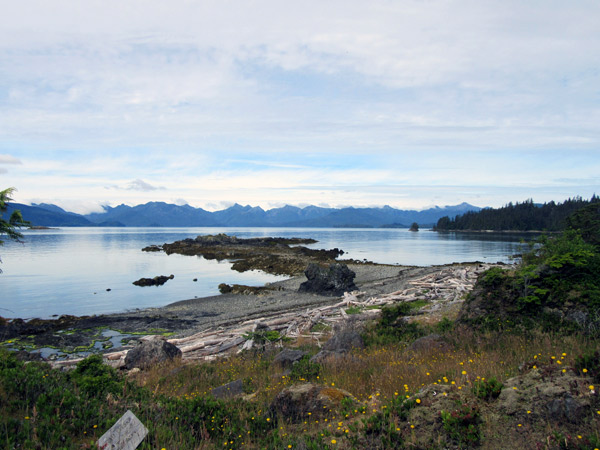
Part 1
Once again Swell has an intrepid group of explorers on board who are getting along famously. Considering the age range spans 71 years between youngest and oldest, it is a wonderful thing. Our voyage began with orientations to safety, the boat and to the Gwaii Haanas area as well as to Oliver’s wonderful cooking. He continues to impress us with each meal.
Our first visit ashore was at Windy Bay. This site is significant both because it is the place the Haida drew the line against logging in the area, and because a new pole, the Legacy Pole was erected a few years ago—the first in this area in 130 years! We understood more about why the Haida did not want this area logged when we stood beneath a 900-year-old giant spruce tree.
Some of our guests have a knack for fishing and the ling cod caught that afternoon became our delicious supper. Our first marine mammals sighted (and smelled!) were Steller’s Sea Lions hauled out on some rocks.
Guests have had time to try out kayaking and cruise the shore line in our inflatable skiffs. Walks have revealed some of the early human history as well as the fascinating nature of the area.
It turns out we have some puffin fans on board and we have sighted both Horned Puffins and Tufted Puffins. People were very moved by our visit to SGang Gwaay, a UNESCO World Heritage Site as we learned the story behind the large collection of mortuary poles standing in their original positions from a young Haida woman who is part of the Watchman Program.
We followed a group of four Killer Whales until they led us up an inlet that became too shallow. An old whaling station made for an interesting visit as we saw the historical photos from the early part of the last century and the remains of the equipment used to render the whales. Up in an old forest we saw the remains of an old dugout canoe that was never completed and on the beach some fresher remains of a whale that had been brought over for people to look at.
As we began to head north, we stopped at a Steller’s Sea Lion rookery and saw numerous pups among all the grumbling beasts. Soon after we were treated to our first Humpback Whale and not long after some Dall’s Porpoises. Soon we will be looking forward to our next meal prepared by our chef. Did I mention we like Oliver’s cooking?
Part 2
On our next morning intertidal explore we discovered both a Bald Eagle nest and how a huge Moon Snail can fit inside its shell. We did a little more whale watching enroute to Hot Springs Island where we learned that in October of 2012, an earthquake shut off the hot water. Since then, new trickles of hot water have started to appear so we checked out both the new seeps and the old pools. There were a few Humpback Whales here and there, and we all cheered when one of them breached.
At the village of T’aanuu we met Walter and Mary and Walter lead us through the ancient house sites. We all had our individual feelings of this very special place. We were welcomed back on board with wine and cheese.
Morning kayaking and skiff rides turned into a wildlife extravaganza. Deer, Raccoons and Harbour Seals were spotted. The grand finale was spending over an hour watching a Black Bear feeding in the intertidal and on the shoreline grasses and sedges.
We had a last visit to a village site, K’uuna (also known as Skedans) where we continued to learn the amazing story of Haida Culture. In the evening we shared the thoughts and feelings of travelling in this very special place. Morning will come too soon and we will all go our separate ways, but with a common bond of our experiences in Haida Gwaii.
– reports from naturalist Sherry Kirkvold
Trip Report: Haida Gwaii, Jul 5-13, 2016, aboard SV Maple Leaf
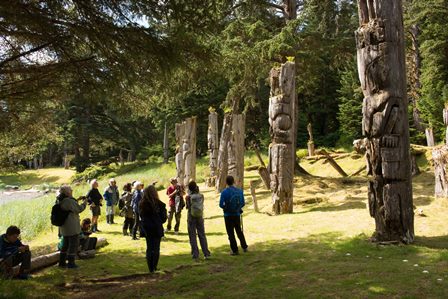
A Large Day
Our fourth day turned out to be a ‘large’ one. We’d started off from mirror-calm, islet-strewn Island Bay to head south towards Rose Harbour. The weather was calm off of Scudder Point so we stopped for a little fishing. While we continued on, watching for humpbacks, shearwaters, and phalaropes offshore, we tucked into fabulous ultra-fresh fish tacos à la chef Lila for our lunch on deck. Looked almost, but not quite, too beautiful to eat!
Before turning into Huston Stewart Channel we drifted by the Steller sea lion haulout at Garcin Rocks. We watched with our binoculars. Most of the colony were resting in the sun and looked like they’d melted across the rock. A few enormous bulls supervised their territories, each with an assembled harem of females. We saw quite a few chocolate coloured pups too, with their mums, and could hear them contributing their goat-like bleating calls to the general growls and mouth-gaping roaring that the adults use to communicate.
On our way to the anchorage at Rose Inlet we saw a white head bobbing in the waves near shore and realized it was a bald eagle on the water, using its wings to swim itself towards shore. We watched it come to a rocky reef where it half hopped and half flew (sending sprays of water off its flapping wings) as it came in with good sized silvery salmon latched in its talons. Too big to carry and unable to let go of the fish while in the water, the big bird had only the option to swim itself to shore. It wrestled the fish up the narrow beach ramp and disappeared with it into the forest under the salal bushes along the high water line.
We wrapped up the day with a beach fire on a long curving pebble beach. Strolling down the beach while looking for firewood, we found an intact light bulb but not too much plastic debris. The picnic was set up on a huge old log across the upper logline while the prawn skewers and roasted baby potatoes warmed up on the fire. We watched the sun drop behind the ridge line and toasted the fabulous day.
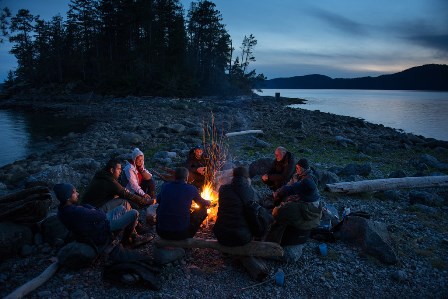
Six Lifers Before 10:00
On our way to cross over to visit SGaang Gwaay and the ancient totems at Ninstints, we paused by the tiny Flatrock Island to look for puffins. We were pretty excited to see both the white-bellied Horned Puffins as well as the all-black bodied Tufted Puffins on the upper cliffs on the lee-side of the island. This is one of the only places in Canada to see nesting Horned Puffins. Cormorants, gulls, oystercatchers and guillemots nest there too, but the puffins are always such a treat to watch.
Over at SGaang Gwaay , we walked the mossy forest trail to the village to meet the watchman and were thrilled to get great views of several more bird species too, including a family group of Fox Sparrows and tiny, flitting Chestnut Backed Chickadees. As we got along the trail into the taller more open forest, we heard the buzzy trill of Varied Thrush and managed to get a good look at one as it perched on a lower bare spruce branch.
We met up with watchman Harold and he told us about befriending little Hermit Thrush along the trail from the cabin to the village. We saw many of these speckled-breasted birds, around the mossy house beams and even perching on the poles, singing their lovely flutey trills. Our Scottish guests, keen birders from the Outer Hebrides Islands, were delighted as could be to have seen these six new birds for their life list and were heard to say: “that’s pretty good! Six lifers and it’s only ten o’clock in the morning!”
– Report by naturalist Mary Morris
Trip Report: Haida Gwaii, Jul 1-8, 2016, aboard MV Swell

July 4th, 2016, Gwaii Haanas
We got up early to take advantage of a morning low tide and were immediately rewarded with sightings of black bears feeding amongst the intertidal rocks. They were turning over rocks as they looked for crabs.
We took the skiff into Burnaby Narrows to explore the amazing intertidal diversity found there. We saw hundreds of bat stars in all their many colours, Moon snails, fat gaper clams and butter clam shells with moon snail borings. Anemones, mussels, crabs and barnacles abounded.
We returned to the Swell for a delicious snack and then a few of us went exploring by kayak for a bit before we weighed anchor en route to SGang Gwaay (Anthony) Island. Along the way, we diverted yet again to watch a humpback.
On arriving at SGang Gwaay we went ashore where we were met by an informative and passionate Haida watchman who then guided us though the magnificent and mystical poles of the village of SGang Gwaay (also known as Ninstints, and a UNESCO World Heritage site). I think of this site as the Macchu Picchu of Canada – without the crowds!
After our village visit, we went for a hike through the forest behind the village before returning aboard. We finished off an amazing day with a delicious halibut dinner at anchor in Louscoone Inlet.
– report from naturalist Mike Jackson
Trip Report: Haida Gwaii + Emily Carr & Art, Jun 27-July 5, 2016 aboard SV Maple Leaf
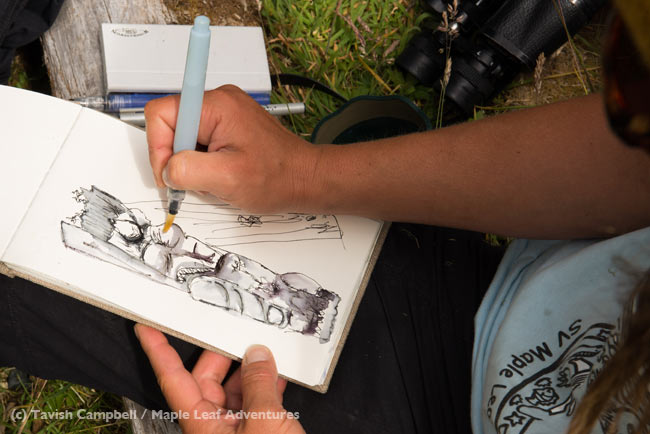
Maple Leaf in a land that Emily Carr painted
Steaming north on sparkling seas under a blue sky:
Today we stopped on Kunga Island for a visit with an old giant-a Red Cedar (42 feet around!) which has been growing here since Medieval times. Yesterday started with a 1.4 foot tide and a colourful circus: huge red spiny sea urchins, long languorous sea cucumbers, decorator crabs bristling with seaweed, turban snails, red rock crabs, and bat stars. There are always surprises under the big tent of Burnaby Narrows—we were intrigued by tiny crabs which had taken refuge every inch or so along the stinging margin of a poached egg jelly (Cyanea sp.) We’ll be following up to try to figure out the natural history of these little guys…
Other highlights: a pod of 5 transient orca just off Windy Bay, sketching at Tanu, in the same place Emily did a hundred years ago, fifty shades of green on a rain soaked walk up the river at Echo Bay, twenty black oystercatchers up to their ankles in gold bladderwrack, a spray tossed crossing of Juan Perez Sound as the wind came round to the west, and waking to a sun for our last couple of days in Haida Gwaii.
– report from naturalist and artist-in-residence Alison Watt
Trip Report: Haida Gwaii June 11-19, 2016 aboard SV Maple Leaf
Maple Leaf in the land of the Kunghit Haida – June 15th
 Morning dawned fair in Heater Harbour as the sun rose to outline one of a myriad of islets on the northeast of the great Kunghit Island (Gangxid Gw) at the south end of Haida Gwaii. A lovely fruit cocktail was served on deck as we weighed anchor and headed out Houston Stewart Channel toward Flat Rock Island for seabird viewing. As we approached, flocks of rhinoceros auklets bounced off the water. There was a great uproar of the nesting glaucous-winged gulls as a bald eagle landed in the colony; likely raiding nests. Gulls swooped and called but the eagle appeared unperturbed. We circled the great rocky island a couple of times and saw nesting and roosting pelagic cormorants, courting pigeon guillemots and tufted puffins.
Morning dawned fair in Heater Harbour as the sun rose to outline one of a myriad of islets on the northeast of the great Kunghit Island (Gangxid Gw) at the south end of Haida Gwaii. A lovely fruit cocktail was served on deck as we weighed anchor and headed out Houston Stewart Channel toward Flat Rock Island for seabird viewing. As we approached, flocks of rhinoceros auklets bounced off the water. There was a great uproar of the nesting glaucous-winged gulls as a bald eagle landed in the colony; likely raiding nests. Gulls swooped and called but the eagle appeared unperturbed. We circled the great rocky island a couple of times and saw nesting and roosting pelagic cormorants, courting pigeon guillemots and tufted puffins.
As we headed past the Gordon Islets, spouts were spotted to the west. Plans for a beach walk were scuttled in favour of whale watching. Humpbacks were passing through the area by Kunghit Island and we had good looks at a mother and calf that surfaced near the boat.
We headed north to SGang Gwaay Island and anchored off the village site. SGang Gway is a UNESCO World Heritage Site and for a while carried the name Ninstints, which was an anglicization of the name of a powerful chief that once resided there. There was a tap on the side of the boat and James Williams, the Haida watchman, asked if we wanted to watch him pull in the halibut gear he had set. Captain Greg jumped at this opportunity and we headed toward Looscoone Inlet to watch. James was a confident and striking figure pulling on the heavy 500 ft. line with 10 halibut hooks that snapped off at intervals. The line was heavy so he suspected there might be a catch. At about hook 5, he pulled a beautiful 40-lb. halibut into his skiff! These unusual looking fish are much sought after for their delicate flavour and white flesh. First Mate Ashley explained that in the larval stage, upon settling to a bottom life, one eye moves up to the dorsal surface . Later, we were able to see the large fish’s dark surface on the top side and the white undersides.
After this excitement, we headed to Adam Rock for some great views of tufted puffins buzzing overhead with their stubby wings, and a few puffins sitting on rocks outside their burrows.
We boated across to the northwest coves of SGang Gwaay, then walked across the island through a magical sort of forest with rocky and root-covered knolls, skunk-cabbage and young mossy spruce. The watchman’s new cabin was abuzz with new activity of construction, supply delivery and the hanging of the halibut. Watchman James Williams brought the village to life with great descriptions of the crests on each pole, the ceremonial raising of poles and the construction of the grand houses that could hold up to 200 or more people (in a potlatch) and provided a winter home for 20-30 people. James described the crests of raven, eagle, frog, cormorant, killer whale, super-natural beings, grizzly and black bear and the ownership of these crests as well as stories, songs and particular foraging locations. We left enchanted by James’ knowledge, strong demeanour and humour, but not before he showed his generosity by giving to us a large fillet of the fresh halibut he had caught this morning. We had a real sense of the life of a Kunghit Haida in this place of strong spirits.
A fine three course dinner prepared by our lovely chef was ready upon return from our most excellent adventure!
– report by naturalist Trudy Chatwin
Trip Update from MV Swell Haida Gwaii, June 9-16
We have experienced so much wonder in Gwaii Haanas, and we are here at Skedans Point (village site of K’uuna) on our last full day, trying to stay in the moment. Trying to think just of the ocean currents, kelp forest, big sky and Haida village site in front of us, and not of leaving tomorrow.
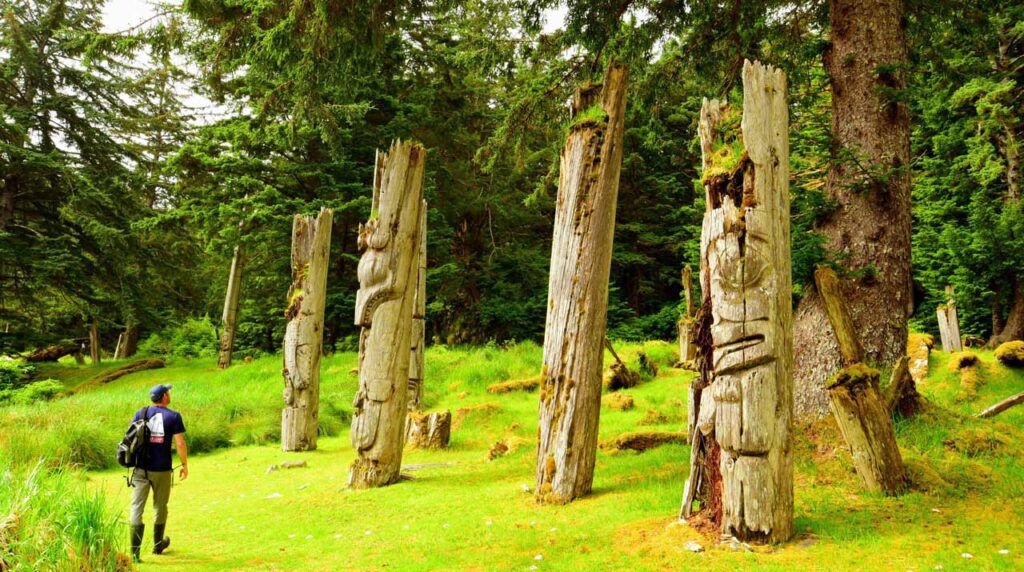
Since we last wrote, we had an amazing tour with Ken the storyteller at UNESCO World Heritage Site SGang Gwaay, explored a west coast beach, spent time with a humpback whale doing percussive feeding in Houston Stewart Channel, and then had our cruising (under way) dinner constantly interrupted by the best kind of event: a multiple-breaching humpback whale just before the appetizer was served, which meant we all needed to get out on deck to watch, and a pod of orcas just as chef Oliver was about to announce the dessert, same routine. We’ve explored lagoons, wondered at jellies, several species of which are our constant companions, listened to the birds of the rainforest and had a wonderful visit at the village site of T’aanuu. Some intrepid adventurers even got up at 2 am to catch opalescent squid from the ship (thank you to naturalist Barb!).
We’ve reflected on everything, from the life cycle of monumental Haida art/structures, to the way the nautical mile was created (thanks first Mate Jordan for the illustrated talk). Our captain Steve planned a route that kept us safe and comfortable but able to feel fully in touch with the forces of life here in Gwaii Haanas, place of wonder.
-update from Maureen

Report from MV Swell on a Haida Gwaii tour through Gwaii Haanas, June 9-16
As I write, Captain Steve on the tugboat Swell navigates the ship through tricky Houston-Stewart Channel. When we nose out of here in fifteen minutes, we’ll have reached the southwest coast of Haida Gwaii. Our primary destination today: SGang Gwaay, the famed Haida village site on an island that backs onto the archipelago, and faces the open Pacific.
Cormorants, rhinocerous auklets and pigeon guillemots fly past the Swell. It’s the beginning of a new day of adventure, although we’ve already stopped at a sea lion rookery and had a great viewing of these bears of the sea and their pups.
Yesterday, although the rain came and went and showed the misty isles living up to their name, we had a fantastic exploration of the south end of Burnaby Island. In Bag Harbour, the moss spread thickly under a highly layered canopy of giant cedars and spruce. Salmon bones littered the bear trail we walked along the creek, learning about the salmon forest, among the evidence.
Then after a warm-up meal by chef Ollie, we explored the colourful and intricate world of intertidal life at the narrows. Naturalist Barb dove down in her snorkel gear and showed us the amazing diversity below, while clams squirted on the beaches beside us. We also spent quite a bit of time with a beautiful Haida Gwaii black bear who was munching on shore crabs and other shoreline delectibles.
After weighing anchor we had a good fishing session in Hecate Strait and then had the most beautiful gift. Under a super bright rainbow a family of 11 northern resident orcas approached. Swimming closely together, in two groups, they logged at the surface and slowly travelled as the sun made beautiful motifs with the clouds and islands off Carpenter Bay.
Update from Maureen
Canadian Geographic Haida Gwaii Expedition, June 1-9, 2016, aboard MV Swell & SV Maple Leaf
Our first day included a warm welcome by Susan and her team at the Masset inn called Copper Beach (home of the cookbook Taste of Haida Gwaii), we explored Tow Hill on northern Haida Gwaii with Andrew Merilees, the mayor of Masset. Then a fantastic welcome at Christian White’s big house where he and his family taught us about Haida cultural traditions and modern life and created a fabulous meal. Then the family sang and performed dances and invited us to participate. Such an incredible welcome to Haida Gwaii!
We were fortunate to have been able to arrange a meeting for everyone with Ernie Gladstone, superintendent of Gwaii Haanas, at the Haida Heritage centre the next day.

T’aanuu Village Site in Gwaii Haanas National Park Reserve Marine Conservation Area and Haida Heritage Site
It is fitting that the expedition cruise with the Royal Canadian Geographical Society included a geographical first! Yesterday, hemmed in Cumshewa Inlet by a storm in Hecate Strait, and with the benefit of the new moon’s big (20-ft) tide, the crew of Maple Leaf and Swell decided to do their first-ever transit of super narrow and shallow Louise Narrows. Typically very small boats transit this cut between Moresby and Louise Islands that dries at low tide. It’s not for the faint of heart to take 2 90-foot wooden ships with 11-foot draughts through. But with good local area knowledge, huge confidence in the ships, and great skill in the crew, the team of expedition leader Kevin, Capt. Steve and Capt. Greg decided to make the transit, so as not to put the ships behind schedule.
With careful preparation, observation, analysis and communication, the team set out at 11:15 am. As the wind gusted, first mate Skye led the way in a zodiac, keeping centre-channel and checking the water and depth. Swell followed her with Capt Steve at the helm, with Maple Leaf and Capt Greg coming after. The captains steered the ships with absolute accuracy, using charts, checks of the water and Skye’s route. The ships moved through the long-ago dredged channel, sometimes with 5 feet of water below the keel. Guests were all out on deck, photographing and documenting the passage, as trees and muddy shoals passed close by the ships.
As the ships steered out of the channel into the wider Lagoon Inlet everyone cheered. The exhilaration of having made the first-ever passage, the skill of the crew and the sense of exploration carried through the rest of the day. That evening after more exploring, with the ships rafted together at Thurston Harbour, we marked the occasion with Bruce Amos, ambassador of the RCGS, present. With a champagne toast, we gave all the guests RCGS caps to memorialize the passage.
It was followed by a moving introduction to Gwaii Haanas by special guest resource person Severn Cullis-Suzuki, in preparation for us crossing the boundary and entering the Gwaii Haanas protected area.
**
Today started with some fishing, and then as we entered Gwaii Haanas a humpback whale breached off the bow several times. What a welcome to this place of wonder! We had a wonderful and lengthy visit at the village of T’aanuu with the watchmen there. This was a special village to start our visits in Gwaii Haanas with, as Severn was adopted into the clan from T’aanuu when she was a teenager, and we really enjoyed her stories and her personal connection.
-Report From Deckhand Maureen Gordon
Haida Gwaii, May 25-Jun 1, 2016, aboard MV Swell
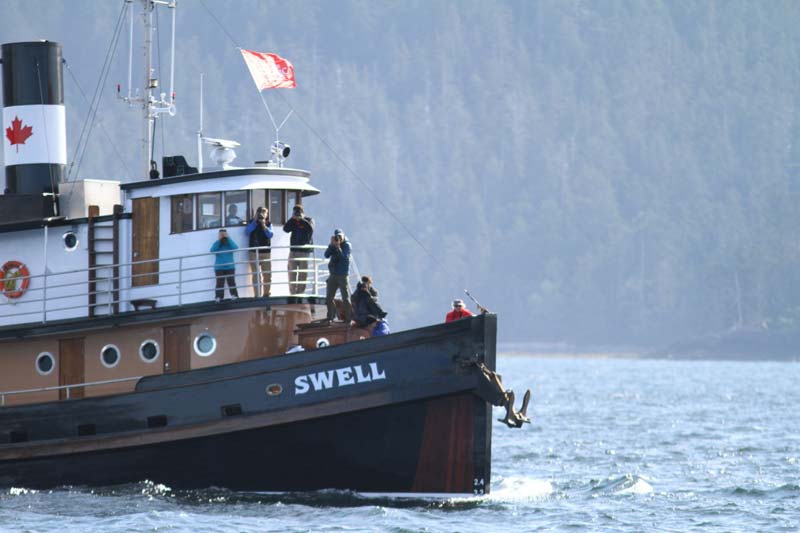
Having a great trip in the islands with an amazing group of folks. Trip highlights so far:
Day 2 A great introduction to Hadia culture & village site with a tour of T’aanuu with Mary & Walter. Mary was very generous and sent us on our way with a beautiful piece of spring salmon that they had caught the night before, which Lila prepared that evening. On our travels south we stopped for a fishing break and landed a beautiful ling cod & a 104cm halibut that was to be enjoyed by all the following day as fish & chips like no other. Thanks Lila!!
Day 3 An amazing morning of viewing many puffins, both tuffed & horned, at Flat Rock Island. Then off to SGang Gwaay for an informative tour with watchman James, to grasp the importance of this village site. That afternoon, the sun came out for a wonderful walk at Bowles Point with a great route through the ancient rainforest and an oppurtunity to stretch the legs on a sandy beach looking for glass balls. To cap the day off, we stopped in at Rose Harbour for a visit of the old whaling station, the chance to meet Goetz & his recently obtained jaw bone from a fin whale.
Day 4 Morning viewing of sea lions @ Garcin Rocks with at least 6 new pups spotted. Our trip to Burnaby Narrows was a great sucsess with Jeff using his extensive marine biology background to enhance our introduction to the facinating creatures of the intertidal zone. That evening as we made our way to De la Beche inlet we feasted on freshly caught prawns and had a tasting of our two styles Maple Leaf beer. Delicious!!!
More to come!
– report from naturalist Greg Shea
Haida Gwaii, May 24-Jun 1, 2016, aboard SV Maple Leaf

Day 3
We were fortunate to have a good low tide about mid-day to float through the shallow tidal channel at Burnaby Narrows. Hundreds of butter clam shells were strewn across the beach flats, squirting small fountains of water as the tide changed. In the shallows we saw the plunger-bottom-shaped egg cases from moon snails and after hanging over the side peering into the clear water we managed to spot a live moon snail, plowing along through the sediment hunting for its next clam meal. We also saw many well-camouflaged giant sculpins. Each one was a different pattern of mottled light and dark, blending perfectly with the shell hash on the bottom. Perhaps they had aggregated in the narrows preparing to spawn?
By the time we were ready to head back to Maple Leaf, the tide had come up to the gravel beach north of the narrows and we were dropped off to stretch our legs for a walk along the last high water swash. As Captain Tavish was bringing the skiff along to pick us up he saw what he thought was a red rock crab headed up the dry beach, away from the edge of the water. As this was an odd sight, he headed to shore for a closer look and to his surprise found a small octopus out for an overland walk! He scooped it gently into the boat bucket to show us all. As we snapped pictures, we quickly released the little guy back to the edge of the beach where it rose up on tiptoe and walked back down the gravel into the water where we watched it jet away. Proof of those stories about octopus wandering from their aquarium tanks, making seemingly impossible getways overland.
Day 4 and 5
Settling into the onboard routines of sumptuous feasts and amazing changing vistas of seas and skies, we were blessed with calm weather to visit the curving sand beach at Woodruff Bay, near the very south end of Kunghit Island. No glass balls were found but we did find a baseball and a half-deflated soccer ball which prompted calls of ‘Wilson!’ and a quick round of beach volleyball. No other human tracks were seen, just deer tracks and a few eagle footprints. So lucky to be able to stay overnight at this anchorage, only possible in the fairest of conditions.
We explored the wildest place on Haida Gwaii, the very southernmost islands of the Kerouard Islands by inflatable boat. We watched Bald Eagles being chased by a pair of Peregrine Falcons, totally outmanoeuvered by these lightning fast fliers. Dozens of barking California sea lions were draped over the rocks on the lee shore of Saint James Island, with the bigger haulouts of Steller sea lions on the outer west rocks. The currents were charging through the narrow passages between the islets and we dodged around the surge channels, soaking up the feeling of this powerful place.
First Mate Skye did sail training a la Maple Leaf 101, and with most favourable wind and tides, we set sail from our Woodruff Bay anchorage to go south around the Cape from the east, and tack north directly to SGang Gwaay (the UNESCO World Heritage Site) up the west coast. An epic sail, as we blasted along at over 8 knots! In exactly the best direction to come in to visit the wonderful old village site of SGang Gwaay for the afternoon.
– report from naturalist Mary Morris
Great Bear Rainforest & Kitlope, May 16-22, 2016, aboard MV Swell
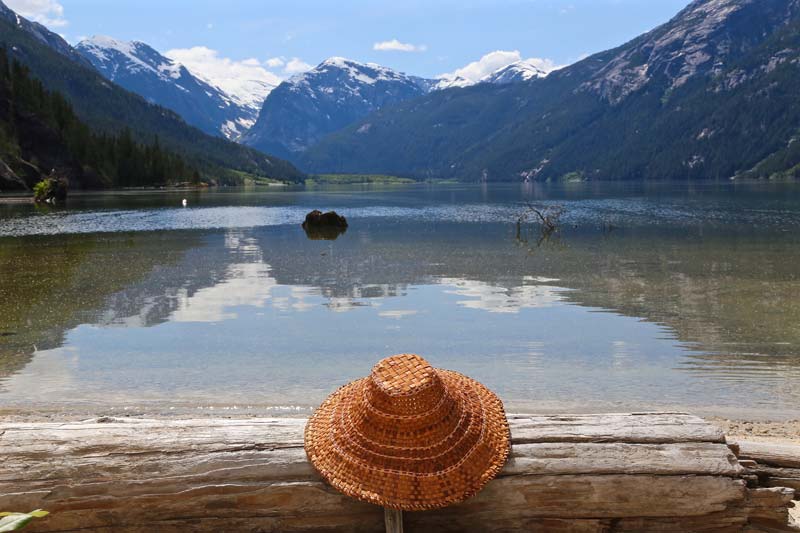
It was with great anticipation that we cast off the lines of Swell and headed off on our adventure into the Great Bear Rainforest and Kitlope Valley. Waterfalls spilled from steep snow-topped mountains as we headed deeper into the Gardner Canal. The water turned to a beautiful green colour as it accumulated the silty runoff from glaciers. We had an epic skiff ride into a long inlet that ended in a beautiful estuary with wildflowers just emerging. Purple, yellow, orangey pink, and even brown flowers inspired an artist in our midst. After our invigorating trip we went for a relaxing soak in a natural hot spring.
Great Bear Rainforest in Spring, May 7-14, 2016, aboard MV Swell
What happens when you put people of several nationalities aboard a converted tug and cruise up into the Great Bear Rainforest? You have an amazing time. We all loved walking on a beautiful white sand beach in the outer exposed islands. Pacific crabapples were in bloom and the sun was shining bright. We also loved cruising deep into a fiord with steep rock walls on both sides. Seeing a grizzly bear at the end was an extra treat.
We spent part of a day poking along the shore at low tide looking at sea creatures – sea stars, sea cucumbers, sea urchins, chitons, snails and many more. Some got wet with a spur of the moment swim in a beautiful green river. We cheered when some Dall’s porpoises came to ride on our bow wake.
In the village of Klemtu we visited their bighouse and learned about the four clans – eagle, raven, wolf, and killer whale. We listened as our local guide told us stories, and answered many questions about culture and life in the village. Not long after leaving we watched as a humpback calf breached over and over and over. Mom was nearby and we could see her, but the exuberance of her young calf amazed us all.
Walking along a huge estuary we could read the news of what had been happening. There were grizzly bear tracks, wolf tracks, as well as those of mink and Canada geese. We had spent a good part of the morning there and were headed back to rejoin the ship when a pair of fists went up to our captain’s head – it was the signal for a bear. We gathered together and watched a nearby grizzly bear feed on sedges. After some time he ambled down to the water for a drink, walked in and started to float. He drifted away and we watched him find a new patch of sedge and start to munch again.
At Cetacea Lab we learned about the research being done with orcas, humpbacks, and fin whales and listened to recordings of their songs. Not long after departure we watched five whales diving together. We arrived at a beautiful white sand beach and hiked up into a magical bog forest. Wine and cheese on the beach followed, and later, two of the crew entertained us with guitars and singing on Swell as the sun set with beautiful colours.
An exploration of a rocky point was underway when we found a beautiful canoe run, where rocks had been cleared away long ago to make a safe landing place for dugout canoes. We followed the run up to the woods and could see signs that this was at least a seasonal settlement. While in the woods we heard a loud smacking sound. We crossed to the other side and a humpback whale breached over and over again.
We have since had some time to reflect on that we have seen and experienced. We all agree it has been a wonderful adventure with a great group of people.
– report from naturalist Sherry Kirkvold
Vancouver Island to Great Bear Rainforest, May 6-13, 2016, aboard SV Maple Leaf
Highlights of this trip included two prolonged encounters with transient (now known as ‘Biggs’) killer whales as well as humpbacks, sea lions (Steller’s and California), a charismatic baby octopus (!), and finding a large colony of abalone grazing amongst incredible seaweed biodiversity and rich intertidal life.
The extreme low tides allowed us to see ancient clam gardens and see large sea urchins that are normally more covered with water.
We also had the opportunity to tour the Hakai Institute, a research station in the Great Bear Rainforest on Calvert Island whose objective is to advance long-term research at remote locations on the coastal margin of British Columbia. (Several of our crew have affiliations with the great work being done at this stellar institute.)
And a short tour of the night sky on our last evening ended with a bright display of bioluminescence in the water – stars above and below!
– report from naturalist Fiona Chambers
Desolation Sound, May 1-5, 2016, aboard SV Maple Leaf
For the beginning of May, we started in what seemed like a summer weather pattern with a high pressure system and hot temperatures. We anchored off Mitelnatch Island and circumnavigated it by zodiac in flat calm seas — unusual for these exposed waters at the top end of Georgia Strait. Amazing birds and sea lions. A great sunset at our anchorage in the Copeland Islands.
Before breakfast the next day, guests had a kayak around the ship in our anchorage. We hauled up a basket of prawns that morning — the first of many good prawn hauls. The crew got some great arm workouts hauling up the traps. Chef Mary did wonders with the shared catch of BC spot prawns.
Then we had a hike to one of Desolation Sound’s beautiful lakes. We had planned to have our lunch on deck at anchor, but because it was so hot we pulled the anchor and got under way to provide cooling, moving air for everyone!
We had a great wine and cheese party on a west-facing point, where naturalist Jolie read to us from the coastal classic book, The Curve of Time by Muriel Wylie Blanchett.
The next day we began to explored stunning Prideaux Haven, one of the areas that Muriel and her 5 children had explored in 1920 and 1930s, and that she wrote about. We explored a beautiful mainland inlet and deliberately arrived for the best tide to explore a river estuary to look for bears. Within the hour we were successful, and got a wonderful view of a mother grizzly bear and her cub in the sedges. We also finally found some rain and mist, for which the coast is famous.
We anchored at Walsh Cove and the next morning had a great viewing of pictographs in the area. We spent the afternoon in the perfect conditions to sail the Maple Leaf and we sailed most of the way around Cortez Island, right into our anchorage. Some celebrated with a swim, some with a beach walk, and all celebrated back aboard the boat later with some lovely, cool prosecco. Chef Mary’s feast that evening was the crowning jewel of the trip. We re-lived the adventure with a slide show of our adventure.
– report from captain Kevin Smith
Vancouver Island to Great Bear Rainforest, Apr 29-May 6 aboard MV Swell
Our trip started in Port McNeill, so we needed to cross Queen Charlotte Sound past Cape Caution in favourable weather. The day we started was windy, so we tucked into the Broughton Archipelago for a night. Fortunately, the following day’s weather was favourable, so we made our run north. The Swell handled the moderate swell admirably, so everyone on board had a pleasant crossing. We were greeted at the mouth of Rivers Inlet by a raucous Steller sea lion haul-out, which was a nice introduction to the diversity of the Great Bear Rainforest.
The following days were spent exploring the myriad islands, coves and channels of the outer coastal islands. We found a wonderful shell midden and historic seasonal camp in the some outer island, which also had recently stripped young cedar trees. The site also had a well-used bear stomp trail and scent marking tree, which added to its appeal. The weather was clear and sunny, so we had gorgeous walks and intertidal exploration of the west coast beaches and islands of Calvert Island. Those experiences were enhanced by the wonderful array of migrating loons, grebes, and shorebirds. Further north in the Spider islands and Simonds group of islands we had numerous encounters with the ever-entertaining sea otters. One curious individual came up very close to the zodiac before it seemed to surprise itself how close it was and finally disappeared. Another group of rafting sea otters moved away in unison porpoising through the water.
From the low-lying outer coastal islands we entered adeep dramatic fiord on a moody, rainy, coastal day. It was nice to have our guests experience the kind of weather the Great Bear Rainforest is named for as almost every other day was beautiful and sunny!
During our trip up a spectacular inlet we were accompanied almost the entire way by a lone transient orca. Later at the head of the inlet, he was being quite acrobatic as he chased some prey, which brought him quite close to the zodiac and allowed everyone on board to experience the sound and smell of his expelled breath. We explored two main estuaries along the inlet and found lots of wonderful bear habitat and some recent bear sign, including feeding sign and bear stomps.
From the inlet we toured south through several main channels and ended up visiting the historic town of Ocean Falls before making our way toward Bella Bella. We had a nice encounter with 3 humpback whales feeding in the channels, including a mother and calf and a lone whale, all of whom were deep diving and showing us their great tail flukes. We’ve been pleased to see Sandhill cranes in a number of places and had a nice send off from one flying over in the morning sun as we prepare to depart for Bella Bella and the end of a wonderful trip.
– report from naturalist Grant MacHutchon
Vancouver Island Inside Passage (southern half), Apr 23-30, 2016 aboard SV Maple Leaf
We journey north with the unfolding of spring. It is a marvel of colour, sounds and smells,including those coming from our tiny galley.
Our view at sea level is framed by the snow-capped beauty of the Olympic, coastal and Vancouver Island Mountains. Out traveling partners are scoters, auklets, Brandt’s cormorants, and even killer whales.
We have hunted for treasure. But it is not buried on De Courcy island. It is found in air and the waves and the forests and islands that cradle our little ship as she discovers the jewels of the Salish Sea.
– report from naturalist Misty MacDuffee
We sailed up Georgia Strait, exploring islands all the way – forest walks to lakes, beaches, and a stop at the village of Lund.
Then it was on into the highlights of Desolation Sound and further down a mainland inlet. Here we explored the majesty of the mountain valleys and watched a grizzly bear mum with her cubs.
An epic journey was had by all.
– With reports from Kevin Smith
Vancouver Island Inside Passage, Apr 21-28, 2016 aboard MV Swell
Our trip started in Sidney, so we were able to take advantage of a lovely couple of days in the southern Gulf Islands. Our first anchorage was in Bedwell Harbour (Pender Island) allowing us to have a lovely walk in the coastal Douglas-fir forest with a multitude of spring orchids.
From Bedwell Harbour we made our way to Narvaez Bay (Saturna Island) for another lovely walk to Monarch Head overlooking Boundary Pass and the San Juan Islands. We were entertained by a cute pair of turkey vultures perched in a standing dead tree at eye height.
From Narvaez we made our way around East Point on Saturna Island and a large haul out of Steller’s sea lions accompanied by of hundreds of Bonaparte’s gulls and a myriad of Rhinoceros Auklets and Common Murres, among other birds.
We made our way to Tumbo Island and a nice walk to the old homesteads there. We enjoyed all the spring flowers on Tumbo Island as well as further north near the Belle Chain Islets the next day.
After our second sea lion haul-out we made a bee-line north for the rest of the day to avoid the predicted strong winds in the Strait of Georgia. We anchored at the south side of Cortez Island, which set us up for a great day exploring the mouth of Desolation Sound and the Discovery Islands.
We enjoyed the waterfall in Teakerne Arm with a short walk to Cassel Lake above. Leaving Teakerne Arm we were delighted to encounter a group of transient orcas in Lewis Channel followed in quick succession by a group of Dall’s porpoises.
After passing through Yuculta and Dent Rapids we had a group of 4 Pacific-white sided dolphins riding our stern wake for many kilometres, as we made our way into the mainland inlets.
We had an adventurous exploration in a river estuary, including a grizzly bear stomp trail (where bears all walk paw-for-paw in the exact same place, making a trail that is like stepping stones), and marking tree in the older floodplain forest, as well as lots of lovely emerging spring plants on the estuary.
Spotting a large male grizzly bear foraging along the intertidal sedge flats, we had an amazing viewing as he made his way along the edge of the river mouth. Its unusual to have a large adult male so tolerant of our presence, so we felt really blessed by the experience. Everyone returned to the Swell elated.
Today we had a lovely kayak and zodiac explore, and enjoyed all the intertidal life we saw as well as some First Nation clam gardens. This was followed by a walk through the western hemlock and cedar forest. We are now anchored in a lovely part of Port Harvey and settled in for the evening after seeing an amazing shell midden on the beach fringing a First Nation village site.
– report from naturalist Grant MacHutcheon
Gulf Islands National Park Reserve Trips
To come.
